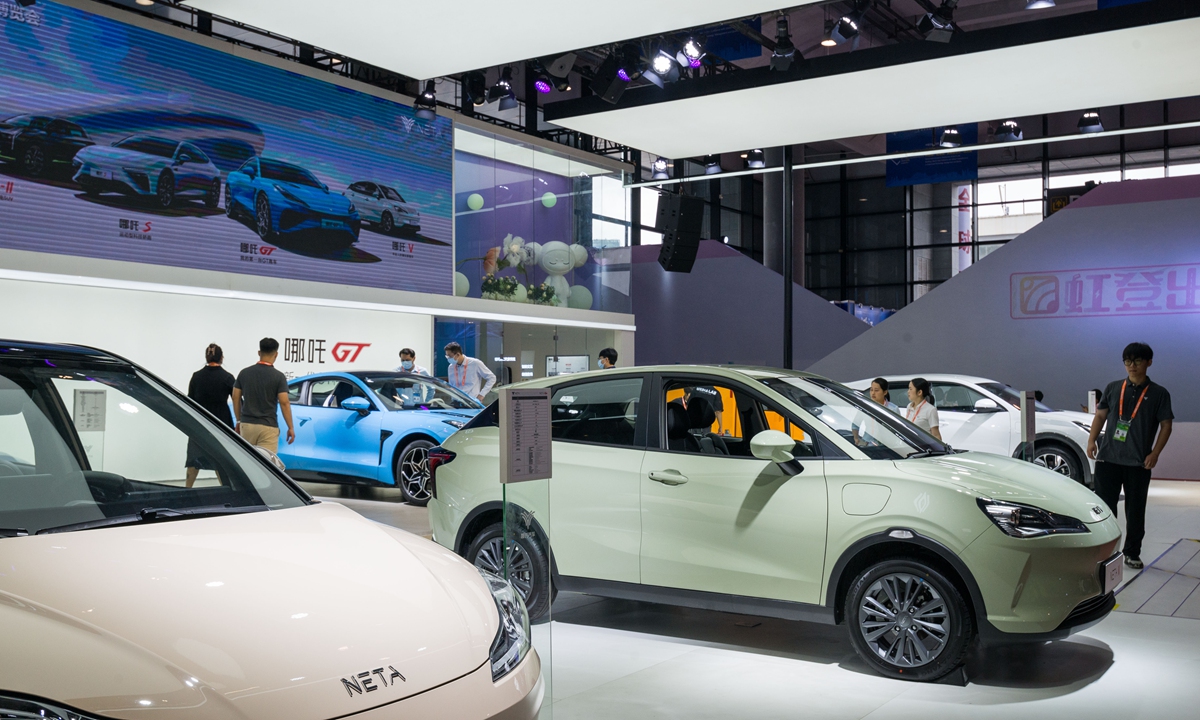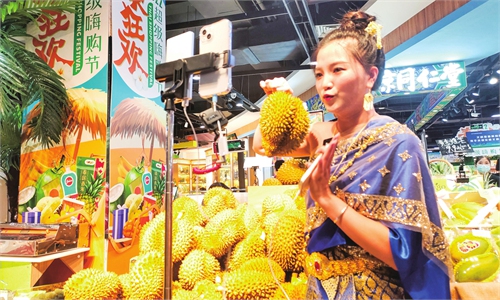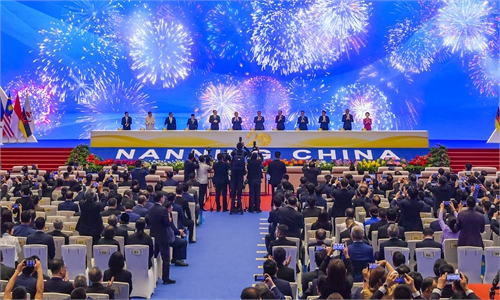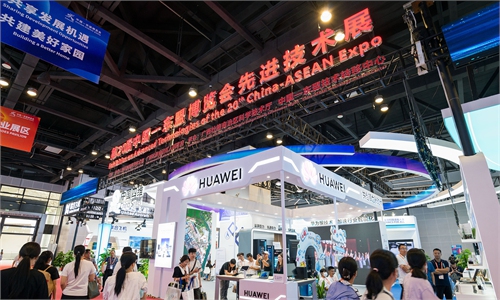Pulse on China’s Economy: High-quality trade, a main growth driver, helps stabilize economy despite pressure

Visitors browse Chinese NEVs at the 20th China-ASEAN Expo on September 18, 2023. Photo: Chen Tao/GT
The 20th China-ASEAN Expo, which concluded on Tuesday in Nanning, South China's Guangxi Zhuang Autonomous Region, saw record numbers of events, cooperation projects and investments.
Nearly 2,000 businesses, up 18.2 percent from 2022, showcased their products at the expo. High-tech products such as intelligent equipment became a highlight at the expo. Particularly, Brunei's decision to purchase 30 Chinese-made airplanes, namely C919 and ARJ21, for more than $2 billion in total became the biggest deal in the expo's 20-year history.
The bustling scene at the expo illuminates an emerging trend in China's trade sector in recent months: Even as Chinese exports face a weakening external demand due to a wide range of factors including profound challenges and rising protectionism in advanced economies such as the US and Europe, China's trade with emerging markets, including ASEAN and countries and regions participating in the joint construction of the Belt and Road Initiative (BRI), continues to rise steadily. Meanwhile, high-value, high-quality Chinese products such as new-energy vehicles (NEVs) and construction equipment are becoming new growth spots.
While foreign media outlets have been hyping claims of "falling" Chinese exports or allegations of Made-in-China being "replaced" by other countries and regions, China's foreign trade remains resilient in the face of external and internal downward pressure, businesses and economists noted. And as exports remain one of the three growth engines of the Chinese economy, high-value, high-quality trade will continue to help stabilize the world's second-largest economy in the coming months and years, they noted.
Resilience in hardship
At the exhibition halls of the China-ASEAN Expo, vendors from ASEAN showed a palpable sense of confidence and interest in boosting trade with China, as they showcased various products, which were emptied by visitors. While ASEAN exhibitors focused more on agricultural products and small commodities, Chinese exhibitors focused on high-tech products such as NEVs and robots.
"The world is currently facing an economic slowdown… ASEAN member countries are pinning their hopes on China," Tan Sri Dato' Low Kian Chuan, President of The Associated Chinese Chambers of Commerce and Industry of Malaysia (ACCCIM), told the Global Times on Tuesday on the sidelines of the China-ASEAN Expo. "It can be seen from the trade volume that China-ASEAN trade has surpassed the EU. We need China, and China also needs ASEAN. Bilateral cooperation will definitely deepen."
In the first eight months of 2023, China's total imports and exports dropped by 0.1 percent year-on-year to 27.08 trillion yuan, with exports growing by 0.8 percent year-on-year to 15.47 trillion yuan, according to data from the General Administration of Customs (GAC). However, there were also plenty of emerging trends that point to the resilience and upgrade of China's trade sector.
From January to August, China's imports and exports with 152 countries that are participating in the joint construction of the China-proposed BRI grew by 3.6 percent year-on-year to 12.62 trillion yuan, accounting for 46.6 percent of China's total foreign trade. China's trade with ASEAN, which remains China's biggest trading partner, grew by 1.6 percent year-on-year to 4.11 trillion, accounting for 15.2 percent of China's total trade. The fall in China's overall trade during the period is largely due to declines in exports to the EU, the US and Japan, which all face stubbornly high levels of inflation.
In terms of top export products, demand for Chinese-made mechanical and electrical products remained high, as exports during the first eight months increased 3.6 percent year-on-year. Exports of cars, including NEVs, skyrocketed by 104.4 percent year-on-year. China's car exports have made headlines around the globe, with many foreign media outlets predicting that China is set to overtake Japan as the world's biggest car exporter in 2023.
A slew of advanced technology exhibits was unveiled at the China-ASEAN Expo. The exhibits cover a wide range of products, spanning aerospace, advanced manufacturing, sustainable development, and digital advanced applicable technologies, offering the audience a glimpse of life in the future. The advanced tech exhibition area covers an area of 3,400 square meters, with a total of 124 exhibitors and 345 exhibiting projects on display.
Gao Lingyun, an expert at the Chinese Academy of Social Sciences in Beijing, said Chinese products still maintain a solid competitive edge even though Chinese exports face challenges such as US' additional tariffs. Gao noted the challenges will be relatively short-term against the backdrop of the trade competition between China and the US.
"The core factor affecting China's trade, namely the competitiveness of Chinese products, has not undergone major changes," Gao told the Global Times on Tuesday, adding that while the role of exports as a major economic engine is decreasing due to the rise of Chinese consumption, China's foreign trade still has a vast potential for development.
High-quality development
New trends in China's foreign trade also underscored high-quality development, in which more markets have been explored and more Chinese-made high-tech products are getting increasingly popular around the world, analysts noted, stressing that an increasingly optimized trade structure that focuses on emerging markets and industries is more sustainable in the long run.
Zhou Mi, a senior research fellow with the Chinese Academy of International Trade and Economic Cooperation, said that one of the biggest highlights of China's foreign trade is that the trade volume with countries participating in the BRI is rising sharply, which in turn lift local economic developments and thus demand. In terms of product offerings, China's exports sector has responded swiftly to demand for the digital economy, green development and other new consumption trends.
"To gauge the global influence of one country's exports, we still need to see whether it can meet the needs of global economic and industrial upgrading, so the quality of exports needs more attention. China's exports are still recovering, and this recovery not only reflected in the quantity," Zhou told the Global Times on Tuesday. "We cannot just focus on increasing the scale of exports, we also need to improve the quality."
Amid the rapidly shifting global geo-economic landscape and the domestic industrial upgrade, China has made high-quality development in foreign trade one of its top priorities, and has taken a slew of measures in this regard. In April, the Ministry of Commerce introduced a series of policies to stabilize the scale of foreign trade and improve its structure, including helping automakers establish and improve their international marketing and service systems, and improving foreign trade financing services for medium, small and micro enterprises. These measures have greatly helped boost relevant sectors such as soaring NEV exports.
Another highlight of China's foreign trade sectors this year is surging exports by private enterprises. In the first eight months, total exports value by private enterprises rose by 6 percent to 14.33 trillion yuan, accounting for 52.9 percent of the national total, according to the GAC.
The measures, which also include extensively resuming domestic offline exhibitions, will continue to help enterprises to explore more markets. China has held a series of trade fairs this year, including the China-ASEAN Expo and the China International Fair for Trade in Services earlier this month. More are under planning, including the China International Import Expo scheduled later this year in Shanghai, which has become a major event for global trade cooperation that focuses on imports.
"I have confidence in China. I believe that China has the conditions and capabilities. Moreover, China is not just the world's largest factory. It can make breakthroughs and cope with the current challenges through its own technological innovation," Low said.





